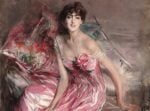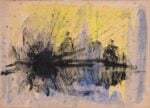Wunderkammer – Ludovica Gioscia / Jebila Okongwu
 (480x439).jpg)
Prendendo spunto dalla natura propria della Wunderkammer (o Camera delle Meraviglie), in Patterns of Trade, Ludovica Gioscia e Jebila Okongwu presentano nuove opere riguardanti le loro rispettive collezioni – personali e in qualche modo ossessive – di immagini e interrogativi sull’arte.
Comunicato stampa
Riccardo Crespi presenta il terzo appuntamento con Wunderkammer un progetto che intende animare la programmazione della galleria con collaborazioni inedite o interventi site specific di artisti giovani o già affermati, italiani e internazionali.
Prendendo spunto dalla natura propria della Wunderkammer (o Camera delle Meraviglie), in Patterns of Trade, Ludovica Gioscia e Jebila Okongwu presentano nuove opere riguardanti le loro rispettive collezioni - personali e in qualche modo ossessive - di immagini e interrogativi sull’arte.
La collezione di Jebila Okongwu è formata da sculture di banane costruite con gli scatoloni dalla grafica stereotipata e ‘tropicalizzata’ che l’artista raccoglie rovistando nei mercati locali e nei negozi di frutta. Okongwu se ne serve per denunciare l'identità 'esotica' spesso impostagli come artista di origine africana. Inoltre gli scatoloni di banane sono stati trasportati in Occidente da Africa, Caraibi e Sud America, secondo le medesime rotte dei flussi migratori attuali o seguendo i precedenti percorsi della tratta degli schiavi nell’Atlantico, richiamando così l’attenzione sullo squilibrio della ricchezza globale e le controversie del commercio post-coloniale.
La collezione di Ludovica Gioscia si compone delle sue caratteristiche carte da parati in cui numerose immagini vengono compresse e ripetute come moduli bidimensionali. Ammassando immagini e pattern, l’artista indica cicli di compulsione e ossessione, ma anche di accumulo e distruzione. Entrambi i cicli riguardano i meccanismi psicologici che sono alla base delle strategie di marketing e del nostro rapporto con il consumo. Molte delle carte da parati stampate per Patterns of Trade, funzionano come ritratti olistici dei grandi brand i cui scarti sono ri-incorporati nei loghi modularizzati.
Per il loro progetto di collaborazione nella Wunderkammer, le collezioni dei due artisti si scontrano per indagare le strategie di marketing e le conseguenti gerarchie sociali, prodotte all'interno dell’economia capitalista globale. Entrambi gli artisti si dilettano con l’eccesso di offerta, l'accumulo, il colore ed il disegno: le banane cucite a mano di Okongwu sono appese accanto alle sculture di carta da parati stratificata e piegata di Ludovica Gioscia, in composizioni apparentemente piacevoli. Le tecniche di cucitura, stratificazione, piegatura e stampa utilizzate dagli artisti sono i medesimi processi che facilitano la fornitura e il consumo di massa, ma in questo caso siamo costretti ad ammettere che c'è un prezzo reale da pagare. Ci vengono ricordati i lati più oscuri dello sfruttamento del lavoro, della pericolosità delle fabbriche del mondo in via di sviluppo e delle ingannevoli tecniche di marketing attuate dai grandi brand per oscurare queste questioni.
Jebila Okongwu è nato a Londra. Le sue mostre più recenti includono Nero su Bianco co-curata da Rober Storr, The American Academy in Rome (Roma, 2015), The Go-Between: A selection of International Emerging Artists from the Ernesto Esposito Collection Museo di Capodimonte (Napoli, 2014), River Crossing, Galleria Lorcan O’Neill (Roma, 2013), The Hawker (performance) The MACRO Museum of Contemporary Art (Roma, 2012), Untold Gold, The Bargehouse (Londra, 2012) e Banana Republic, Gallery Barry Keldoulis (Sydney, 2012)
Ludovica Gioscia (nata a Roma nel 1977) vive e lavora a Londra. Tra le sue mostre personali ricordiamo Neurotic Seduction Astral Production, John Jones Project Space (Londra, 2014), Mineral Rush Flamingo Crush, Galleria Mangiabarche (Calasetta, 2013), Vermilion Glow Bleeds Rust, Galleria Riccardo Crespi (Milano, 2013), Forecasting Ouroboros, Macro (Roma, 2012), Wild Boys, Vitrine (Londra, 2010), Mikado, Siobhan Davies Studios (Londra, 2009) e Papered Portraits, The Warhol (Pittsburgh, 2009).
-------------------------------
Riccardo Crespi presents the third appointment with Wunderkammer, a new project that is intended to liven up the programming of the gallery with original interventions, hosting selected works or site-specific installations by young or already established artists, from Italy or abroad.
Taking their cue from the very nature and history of the Wunderkammer or Cabinet of Curiosities, in Patterns of Trade, Ludovica Gioscia and Jebila Okongwu are presenting new works showcasing their personal and somewhat obsessive collections of images and artistic concerns.
Okongwu’s collection consists of banana sculptures constructed from the clichéd, tropicalized graphics printed on banana boxes which he scavenges from local markets and fruit shops. He uses these to comment on the ‘exotic' identity often imposed on him as an artist of African descent. The banana boxes have been shipped to the West from Africa, the Caribbean and South America. They follow the exact routes of current migrational flows and those before of Atlantic slave trading. They also initiate dialogues on the imbalance of global wealth and the polemics of post-colonial trade.
Gioscia’s collection is accumulated with her trademark screen printed wallpapers in which samples of her numerous images are compressed and repeated as two dimensional patterns. By amassing images and patterns she explores cycles of compulsion and obsession and also accumulation and destruction. Both cycles relate to the psychological mechanisms that underpin marketing strategies and our relationship with consumption. Many of the wallpapers printed for Patterns of Trade function as holistic portraits of mega brands, in which the latter’s own waste is re-incorporated within its patterned logo.
For their collaborative project in the Wunderkammer, the collections of these two artists collide and the result is an examination of marketing strategies and the resulting social hierarchies produced within our global capitalist economy. Both artists delight in excesses of choice, accumulation, colour and pattern and Okongwu’s hand stitched banana sculptures are hung next to Gioscia’s layered and folded wallpaper sculptures in seemingly pleasing arrangements. The artists’ techniques of stitching, layering, folding and printing are processes that are required to facilitate mass supply and consumption but on further reflection we realise that there is a very real price to be paid. We are reminded of the darker sides of the exploitation of labour, the dangerous factories of the developing world and of the deceptive marketing techniques implemented by mega brands to obscure these issues.
Jebila Okongwu was born in London. Recent exhibitions include Nero su Bianco co-curated by Rober Storr, The American Academy in Rome (Rome, 2015), The Go-Between: A selection of International Emerging Artists from the Ernesto Esposito Collection Museo di Capodimonte (Naples, 2014), River Crossing, Galleria Lorcan O’Neill (Rome, 2013), The Hawker (performance) The MACRO Museum of Contemporary Art (Rome, 2012), Untold Gold, The Bargehouse (London, 2012) and Banana Republic, Gallery Barry Keldoulis (Sydney, 2012)
Ludovica Gioscia (born 1977, Rome) lives and works in London. Among her solo shows: Neurotic Seduction Astral Production, John Jones Project Space (London, 2014), Mineral Rush Flamingo Crush, Galleria Mangiabarche (Calasetta, 2013), Vermilion Glow Bleeds Rust, Galleria Riccardo Crespi (Milan, 2013), Forecasting Ouroboros, Macro (Rome, 2012), Wild Boys, Vitrine (London, 2010), Mikado, Siobhan Davies Studios (London, 2009) and Papered Portraits, The Warhol (Pittsburgh, 2009).



